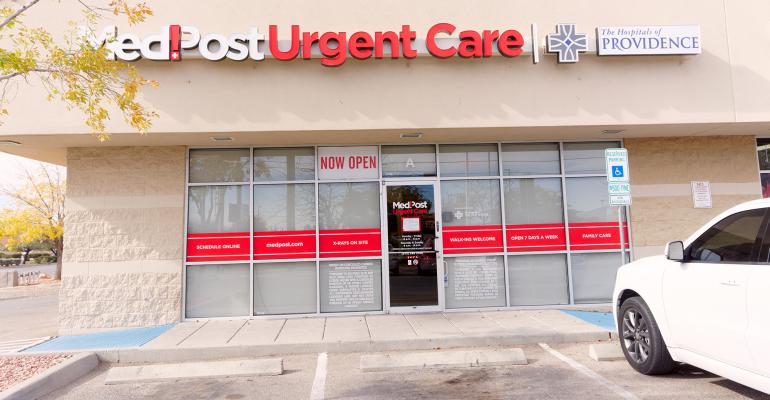In spite of a brief slowdown caused by the COVID-19 pandemic last year, medical practices are back to leasing space at shopping centers throughout the country.
“We’ve seen an uptick in growth of these types of tenancies as consumers continue to seek convenient, on-demand care,” says Alanna Loeffler, business development director of Americas retail services with real estate services firm Cushman & Wakefield. Loeffler has been tracking this trend for the past five years. Over that time period, she’s noticed a 57.6 percent increase in urgent care facilities at retail centers.
In leasing mode
“From a national perspective, we’re seeing a lot in the urgent care and stand-alone medical clinic space—these companies are looking for more visibility to their consumer, with proximity to other community amenities that add to their convenience factor,” says Loeffler. Veterinary clinics taking space at shopping centers are also on the rise, she says, perhaps in response to the increase in new pet owners that sought companionship through the pandemic.
In addition, regional hospitals continue expanding their footprints and want the ability to perform certain procedures off-campus, according Andrew Sellet, Loeffler’s colleague at Cushman & Wakefield. “Due to the COVID-19 experience, they are trying to get anyone who does not need to be in the hospital out of the hospital,” he says, pointing to diagnostic imaging tests like MRIs, CTs, and X-Rays that can be done off-site.
While the pandemic did have a negative impact on the leasing rates in the medical retail sector, a team of consultants from the research firm the CoStar Group says the healthcare/retail partnership is picking right back up where it left off.
“It was definitely fast growing for a number of years now,” says Senior Consultant Kevin Cody. “It slowed down, but we do expect it to pick back up and return closer to where it was before.”
As of the first quarter of 2021, 2.2 percent of retail space in the U.S. is occupied by medical tenants, according to CoStar data. That figure was in-line with the figures from the first quarter of 2020. The lack of momentum in new leasing last year was largely due to lockdown measures and social distancing requirements, CoStar analysts say.
Today, some of the more common medical practices assuming recent tenancies at shopping centers include stand-alone physician, dentist and other health practitioner practices, adds Alexander Levy, senior consultant with CoStar.
These types of medical tenants are looking for spaces in open-air centers with retail anchors like grocery and drug stores, says Chris Wilson, executive vice president, national retail agency lead for real estate services firm JLL. The preferred size for these spaces generally ranges from 25,000 to100,000 sq. ft.
“These tenants want access to the daily needs of a neighborhood retail consumer and to provide them with that same access and convenience,” he notes. Wilson notes that medical tenants at shopping centers are typically paying premium rents due to their desire for the best available space, high build-out costs and higher than retail-standard parking requirements.
According to real estate services firm Colliers International, medical office rents have consistently hovered around $4 per sq. ft. over the last six to eight years.
But there are several reasons why retail center owners would want to target medical office tenants, especially today, when many retail chains are still experiencing pandemic-caused financial issues, notes Robin Trantham, a CoStar Group consultant.
“One would be the stable tenancy—these medical office tenants tend to sign on for longer lease terms and they also tend to have higher credit ratings,” he says. “In some cases, retail owners are seeking out these medical office tenants to backfill space in their centers to make up for the move-outs that are caused by the challenges that retail has experienced over the last few years.”
Another benefit is that the medical service providers are more resistant to competition from e-commerce, adds Levy.
Trantham admits there are some challenges associated with bringing these tenants into a shopping center, such as different operating hours and different parking requirements, but ultimately the benefits tend to outweigh the costs.
Retail centers emerging as a competitor to MOBs?
In the purpose-bult medical office sector, average vacancy increased by 67 basis points over the course of 2020, but remains relatively tight at 8.7 percent as of first quarter of 2021, according to CoStar. But lately, that sector hasn’t been seeing much of new deliveries, according to Cody—the amount of space currently under construction totals less than 1 percent of the existing stock.
“It may have been overbuilt at some point, but with the drivers that we’ve mentioned before, you probably would’ve expected to see more construction over the most recent economic expansions over the past decade or so. Medical office supply growth has been really low. And meanwhile, retail has obviously been going through its own sort of evolution.”
As lots of retail tenants have been moving out, filing for bankruptcy protection and closing stores, retail landlords have been trying to backfill the vacant space and healthcare “has been a good, strong grower of retail leasing space,” Cody says.





